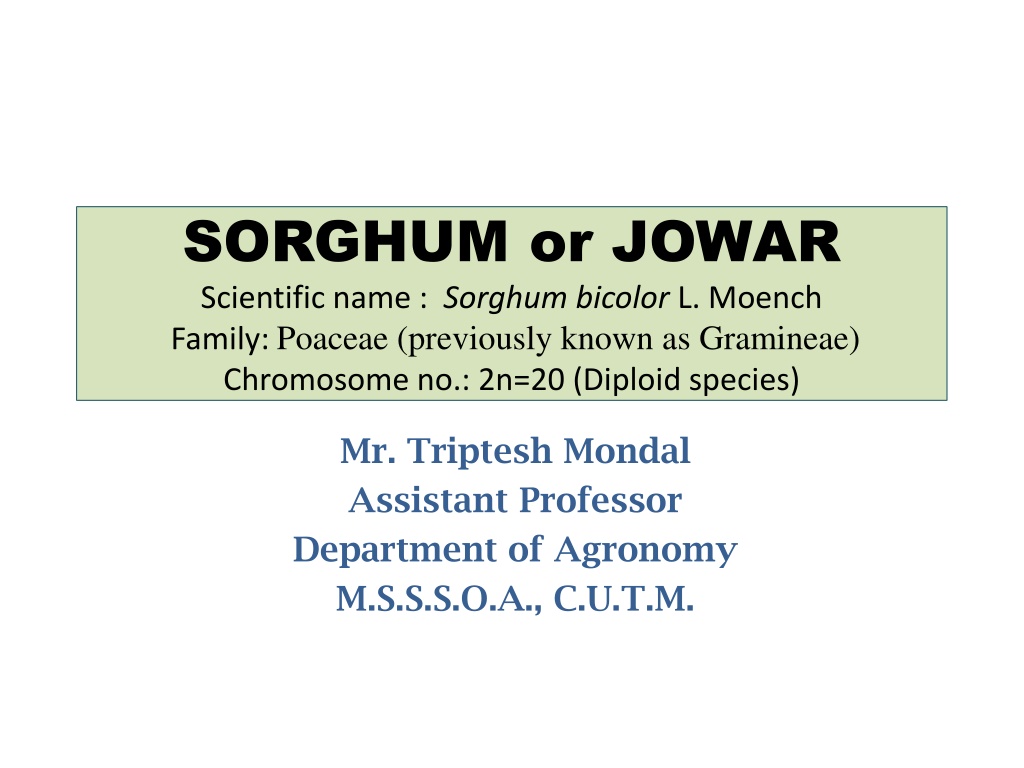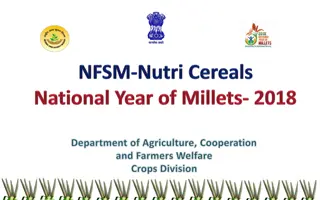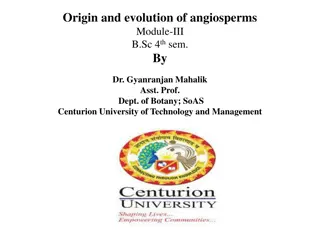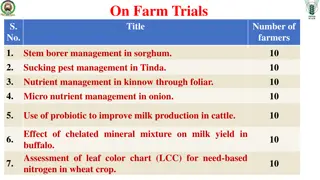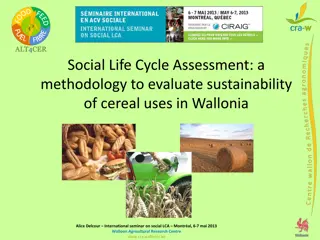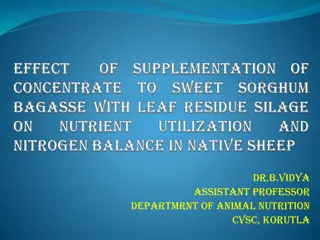Importance, Uses, and Origin of Sorghum (Jowar)
Sorghum, known as Jowar, is a significant cereal crop cultivated worldwide. It serves as a staple food for millions in Africa and Asia, while also being utilized as animal feed. With the ability to withstand drought, sorghum is valued for its resilience and nutritional benefits. The grain is used for various purposes such as food preparation, feed for animals, and even biofuel production. Originating from East and Central Africa, sorghum has a rich history dating back to ancient times.
Download Presentation

Please find below an Image/Link to download the presentation.
The content on the website is provided AS IS for your information and personal use only. It may not be sold, licensed, or shared on other websites without obtaining consent from the author.If you encounter any issues during the download, it is possible that the publisher has removed the file from their server.
You are allowed to download the files provided on this website for personal or commercial use, subject to the condition that they are used lawfully. All files are the property of their respective owners.
The content on the website is provided AS IS for your information and personal use only. It may not be sold, licensed, or shared on other websites without obtaining consent from the author.
E N D
Presentation Transcript
SORGHUM or JOWAR Scientific name : Sorghum bicolor L. Moench Family: Poaceae (previously known as Gramineae) Chromosome no.: 2n=20 (Diploid species) Mr. Triptesh Mondal Assistant Professor Department of Agronomy M.S.S.S.O.A., C.U.T.M.
Importance of sorghum: Sorghum is the 5thmost important cereal crop (after wheat, rice, maize and pearl millet) on the globe and native to sub-Saharan Africa, is traditionally grown for grain both as food (Africa and India) and as animal feed (developed countries like USA, China, Australia etc. and stalks as fodder. Sorghum ranks 3rdin the major foodgrain crops of our country. It is cultivated primarily as a crop both during kharif and rabi. One of the main reasons for low average yields (864 kg/ha) is mostly grown in marginal lands which do not suit for maize and wheat. Millions of people in Africa and Asia depend on sorghum as their staple food. The greatest merit with jowar is that it has capacity to with stand drought due to waxy coating on stems and leaves, known as camel crop . It is one of the most widely grown dryland foodgrains in India. Sorghum is called by various names in different places in the world. In Western Africa: great millet, kafir corn or guinea corn, which represents a connection with corn or millet. In India: jowar; In China: Kaolian; In Spain: milo. Sorghum grain contains 7.4-14.2% carbohydrate, 1.2 - 3.5% fibre and different minerals like Ca, P and Fe. Compared to other cereals, sorghum protein is deficient in lysine (1.4 -2.8%) and rich in leucine (7.4-17.0%). Lysine is required for bone formation. Children are more susceptible to lysine deficiency than adults. protein, 2.4-6.5% fat, 70-90%
Uses of sorghum: Jowar grain is mostly used as human food (55%) and animal feed (38%). Grain is sometimes fed to cattle, poultry and swines. Jowar stalk is also used as fodder for animals. Chopped green stems and foliage of sorghum are used to prepare hay or silage and also as pasture crop. Sweet sorghum & pop sorghum are perched and consumed by human beings. Jowar flour is used for preparation of roti. It is also used in breweries to prepare alcohol and malting purposes. Jowar cake can also be prepared from fermented dough. Sweet sorghums are used to prepare syrups, biscuit making in bakeries. Left over stubbles are used as a source of fuel. Tribals eat sorghum grains and sweet stems containing 10% sugar. "Vani jowar" is a speciality of South Gujarat which is eaten under green perched conditions. Jowar dhani i.e., pop sorghum is very popular among children. Sweet sorghum is emerging as a potential feedstock for biofuels. Cyanide (HCN)/Dhurin toxicity: Sorghum varieties produce toxic quantity of cyanide (dhurin alkaloid). The cyanide concentration is highest in seedling stage and declines as the plant grows.
Origin and history: East and Central Africa (in or near Ethiopia/Sudan) is regarded as the place of origin of sorghum because of the greatest diversity of types grown in that region. The diversity of cultivated types decreases towards, Southern Africa and Asia. The oldest cultivation record dates back to 3000 B.C. In Egypt. The trading route between East Africa and India via Arabia is ancient. Sir George Watt (1893) pointed out there was no specific Sanskrit name for sorghum. It is therefore, supposed that sorghum reached in India in 1500 BC.
Area, production and productivity World area is 40.25 million hectares with a production of 58.7 million tonnes and productivity of 1.46 t/ha (FAOSTAT, 2020). India, Africa, USA, Mexico, Nigeria, Sudan, Ethiopia and Australia are the major sorghum producing countries. Globally, the sorghum area declined from 51 mha in 1980s to 40 mha in 2009, while the productivity increased from 1300 kg/ha to 1400 kg/ha during this period owing to adoption of improved sorghum cultivars and management practices. In India, sorghum is cultivated during both rainy and post rainy seasons, mainly as rainfed crop (92% of the area). In India, jowar is grown in 5.5 million hectares with a production of 4.77 million tonnes and the average yield is 0.87 t/ha (FAOSTAT, 2020). Above 1/3rdsorghum area has been covered by Sudan, Nigeria and India together (FAO, 2019). While India leads (3rd) in the world in acreage after Sudan (1st) and Nigeria (2nd), USA ranks first in production followed by Ethiopia and Mexico, respectively. In India, Maharashtra is the largest sorghum producer followed by Karnataka, Madhya Pradesh and Andhra Pradesh.
Classification of sorghum: Sorghum includes annual cultivated forms from Asia and Africa and perennial form from Southern Europe and Asia. Three species are recognized: Sorghum halepense L. Pers. (2n = 40): A rhizomatous perennial species with creeping rhizomes, pedicellated spikelets deciduous when mature, and up to 25 cm long. Sorghum propinquum Kunth Hitchc. (2n = 20): A rhizomatous perennial species with creeping rhizomes, pedicellated spikelets deciduous when mature, sessile spikelets acute to acuminate, lower glume with the keels ending without or with only obscure teeth, leaf blades broad, panicles large and plants are 20-60 cm long. Sorghum bicolor L. Moench: Annual form and cultivated. Species Sorghum bicolor comprises three subspecies: bicolor, drummondii and verticilliflorum. Based on mature spikelet types, Harlan and de Wet (1972) divided cultivated sorghum (Sorghum bicolor subsp. bicolor) into 5 basic races: bicolor, guinea, caudatum, kafir and durra; and 10 hybrid races: guinea-bicolor, caudatum- bicolor, kafir-bicolor, durra-bicolor, guinea-caudatum, kafir-caudatum, durra- caudatum, guinea-durra, kafir-durra and guinea-kafir.
Fig: Panicle and spikelets of 5 basic races of cultivated sorghum
Botanical description Root: The early temporary root in sorghum is the single radicle of the germinating seedling. Seminal roots develop directly from the elongation of the radicle and can be easily distinguished by its continuity with the base of the culm. The remainder of the fibrous root system develops from lowest node of the stem. They are liner & more fibrous than maize. Mature roots are adventitious and nodal roots. Seminal roots are reported to survive up to 4-5 days by which time the adventitious roots develop from the base of the coleoptile. These roots become active up to flowering stage. The nodal/crown roots develop from the lowest node of the stem 30-40 days after emergence and are heavily branched. These roots are strong and green. Nodal roots are active from anthesis up to maturity and support the stem. Depending on the cultivar, the prop root development may occur from the axillary buds on the lowest node of the stem above the ground level. These roots are strong & light green in colour. These roots give support to the stem.
Stem: The stem or culm is made up of a series of alternating nodes and internodes encircled by leaf sheaths. Sorghum stems are solid though the centre but may become spongy, with spaces in the pith. The stem measures 0.5 to 5.0 cm in diameter near the plant base and becomes narrower towards peduncle. The stem grows to a height of 0.5 - 4 m at maturity depending on the cultivar. The culms are made up of 7-18 nodes and internodes but it differ with culitivars. The nodes appear as a ring at the base of the leaf sheath. A bud is present at each node, except at the flag leaf. Sometimes these buds develop into auxiliary tillers while basal tillers are formed at 1stnode. Generally, basal tillers are not produced.
Leaf: Sorghum has 4 embryonic leaves. The leaves on the main stem vary from 14-17 depending on cultivar. Mature leaves may attain a maximum length of 135 cm and a width of 10-15 cm. The terminal leaf is called flag leaf. Leaves are glabrous with smooth leaf margin. The leaf sheath may vary between 15 and 35 cm in length. The leaf sheath is smooth with a powdery bloom of wax on the upper side.
Panicle: The inflorescence is a panicle also known as head with a central rachis from which primary branches arise. The panicle consists of several spikelets in pairs, one of them being sessile and fertile, the other being pedicelated and male or sterile. The size of the panicle ranges from 7.5 cm to 50 cm in length and 4 to 20 cm in width. The peduncle (the uppermost internode which bears the inflorescence) commonly known as neck may be straight or curved downwards. The panicle is composed of numerous spikelets, which usually occurs in pairs, one of them being sessile and the other pedicellate. The sessile spikelet has two glumes. The glumes enclosed two florets. The upper floret being perfect, the lower one being sterile and consisting of lemma only.
Grain: Sorghum grain is caryopsis. Grain is a ripened ovary with attached glumes. The grain colour may be white, yellow or brownish-yellow. Sorghum grains consists of endosperm, pericarp, testa and germ. Endosperm may be soft and floury or hard and corneous. The 1000-grain weight varies from 25-30 g.
Climatic and soil requirements: It is a sturdy crop and can withstand varied climatic hazards more than any other crop. It is successfully grown in arid areas of UP, Rajasthan and also in humid regions of West Bengal and Bihar. It is primarily a tropical warm weather crop. It can withstand wide range of temperatures varying from 15.5 C to 40.5 C with rainfall variations of 35-150 cm per annum. The minimum temperature for seed germination is 7-10 C. It needs about 26-30 C temperature for its optimum growth. Although it is a crop of plains, it grows within plateau region of South India up to an elevation of 1000 m. Sorghum is a short day plant (C ). Flowering and grain formation starts when day length shortens during winter. Soils: Sorghum can be grown in heavy black soils to red soils, but thrives weII in heavy black soils. The best crops are grown the clay loams. Jowar does not grow well under gravely and marshy soils. The crop grows well in the pH range of 6.0-8.5. This crop can tolerate considerable salinity and alkalinity.
Growth stages of Jowar: A fairly simple classification is based on 3 growth stages (GS1, GS2 and GS3) and are described as follows (Vanderlip and Eastin): GS1 (Emergence to PI) : Growth stage 1 is a strictly vegetative period. Relatively little information is available how this stage influences sorghum yields. It is necessary for producing sufficient leaf area and functional root system to support maximum grain development. The duration ranges from 33-45 days. GS2 (PI to Anthesis) : This is very critical stage (panicle development stage), since maximum potential seed number is set. Higher seed number has generally is the most important yield component associated with increasing yield in sorghum. The duration ranges from 35-40 days. GS3 (Anthesis to Physiological maturity): It is grain filling stage. Ultimate yield is the function of both the length of the grain filling period and metabolic or photosynthetic efficiency. Formation of black layer at the base of grain signals the end of this stage. The duration ranges from 40-45 days.
Land preparation: Jowar is a poor man's crop which is mostly grown under low input conditions. However, the preparation of land for sowing of jowar is not as thorough as for most of the cereals. In black cotton soil areas, if the land is infested with weeds, ploughing followed by harrowing is practiced. The land is worked with blade harrow (bakhar) for 2-3 times, sometimes gorru without seeding attachment is worked for 2-3 times where land is weed free or with few weeds. 1stploughing with soil turning plough or tractor discing is advisable for loosing 20-25 cm deep soil. Then good tilth should be obtained by 2-3 harrowings after 1stploughing. Thereafter finally planking should be done. Cattle manure may be applied 12 t/ha and mixed with 'soil by ploughing or harrowing. In case of irrigated crop, after sowing and covering of the seed, beds are formed with the provision of irrigation channels to irrigate the beds. An irrigation channel is formed for every pair of beds to irrigate the beds situated on either side of the channel. In case of transplanting, beds are formed first, water is let into the beds to soak the land and seedlings are transplanted. For an irrigated crop, the best system is to form ridges and furrows, adopting a spacing of 45 cm apart with the provision of irrigation channels at 7.5-10 m apart across ridges and furrows to adopt furrow irrigation. At the time of sowing, dibble/drill the seeds by the side of the ridge at a distance of 1/3 from the top of the ridge.
Ploughing, harrowing and planking in jowar is necessary for: 1. Good seed bed 2. Reducing weed population 3. Preventing soil erosion 4. Conserving soil moisture 5. Conserving entire rainfall in dry areas for the use of jowar crop 6. Providing drainage in wet and humid areas 7. Mixing up organic manures in the seed bed YEAR ROUND TILLAGE: To assist the farmers in combating weeds and to carry out sowing under improved seed bed conditions with this tillage and seeding equipment using bullock power "a year round tillage programme" was developed at CRIDA, Hyderabad. The year round tillage has several advantages: 1. The primary tillage with country plough in the kharif is done during the non crop season when the farmers are relatively free and at a time when the land and bullocks are in good condition. This operation minimizes carryover of weed population from one crop season to another. 2. The subsequent harrowing operations have the advantage of a thorough weed control. Firm seed bed and conservation of moisture in the seed zone which in turn enables early planting and good plant stand is so vital for increasing the productivity in dry lands. In an intercropping system, is necessary to till or harrow the field immediately after the harvest of one of the component crops as otherwise weeds take over and the yield of longer duration component is drastically reduced.
Seed rate, spacing and method of sowing: Sorghum is sown by various methods in different parts of our country. The methods are: transplanting and ratooning. 1. BROADCASTING: This method is not much used by farmers because the seed rate requirement is more and the distribution of the seed is also uneven. Seeds are broadcasted and are covered by working with a country plough. The seed rate varies from 12-18 kg/ha. Dry lands require less seed rate than irrigated lands. This method is usually done in irrigated lands where beds and channels are made and for sowing of fodder sorghum under irrigated farming. 2. DRILLING: It is carried out by locally prepared seed drills, gorru and covered by guntaka or brush harrowing. Seed rate is 8-12 kg/ha. Higher seed rate is recommended for light soils and low rainfall areas while lower seed rate is given for black soils. Spacing of 45 cm x 15- 20 cm and at 3-4 cm depth is optimum. 3. DIBBLING: It is a time consuming method and requires more human labour. It is otherwise economical because the seed requirement is much less. Seed rate is 6 kg/ha and gives the equal opportunity to all plants for their growth from the beginning. It is recommended where labour is not a constraint for both kharif and rabi jowar in order to obtain higher grain yield. broadcasting, drilling, dibbling,
Seeds are dropped in plough furrows directly or through bamboo tube attached to plough (akkadi) since the land will be levelled thoroughly and marked with a marker crosswise, keeping a distance of 45 cm x 15 cm. The seed is covered by the succeeding furrow. This method is adopted usually in dry lands, where the moisture content of the soil is low. In case of irrigated crop, 2 or 3 seeds are dibbled by the side of the ridge adopting 12-15 cm spacing in the row, where ridge and furrow method is adopted. Depth of sowing will be around 2.5 to 5 cm by adopting population of 1.8 to 2 lakhs/ha. Thinning is to be done at 15 to 20 DAS leaving one seedling per hill. Fill up the gaps with the pulled seedlings. This method is usually practiced in sorghum research centres. 4. TRANSPLANTING: In areas with sufficient rainfall, transplanting of jowar seedlings is done. This practice is prevalent in the districts of Srikakulam, Vizag, E&W Godavari districts with regard to cultivation of KONDA JONNA during July- August. When the soil gets sufficiently moist, seedlings of jowar obtained from a nursery after topping the leaves are dropped in the plough furrow. The root portion of the seedlings is covered when the next furrow is opened. As an irrigated crop, the beds of the field are irrigated and seedlings are planted. A light irrigation before or soon after planting helps for better establishment. The transplanting method is mostly used for hybrid sorghum. In Tamilnadu and in adjoining areas of Tirupathi, the seed growers follow the transplanting method. This method is developed by them for obtaining perfect synchronisation of male and female lines of sorghum hybrid CSH-5. The female Iines are dibbled by hand or drilled directly in the fields. The male lines are sown in the nursery bed. The 2 week seedlings of male lines are then transplanted in the field in the ratio of 4 female lines to 2 male lines. Due to transplanting of male lines, the flowering in the male lines would be delayed by about a week. Due to this method, the farmers in South India are able to organize a good hybrid sorghum seed production programme than North Indian farmers.
5. RATOON CROP: The cultivation of an additional crop from the regrowth of stubbles of previous main crop after its harvest, there by avoiding reseeding or replanting such as sugarcane, sorghum, rice, fodder grasses etc. Hybrids of sorghum can be ratooned with good success. They give extra 11 quintals yields to the main crop if they are properly managed. Out of all CSH-1 is the best for ratooning and the local varieties are not at all fit for ratooning. This method is only possible under irrigated conditions. Steps of ratooning: 1. The main crop has to be harvested while the stem is green, leaving 4 to 6 stubble above ground level. 2. On the 2nd day after harvesting, an irrigation has to be given to induce sprouting from the nodes. 3. Fertilizers @ 60 kg N/ha has to be applied at 2 splits. 1st split at the basal stage and the 2nd split of N at 30 days after from date of ratooning. 4. From each stubble, a number of sprouts come up. The weak sprouts have to be thinned out leaving 2 or 3 good healthy sprouts in each stubble 5. Maintain sufficient moisture from boot leaf to grain hardening stage. 6. The ear head size though small in ratoon crop gives equal yield to main crop as it put forths 2 or 3 sprouts. 7. Ratoon comes to harvest in 80-85 days time period. 8. Plant protection measures have to be taken up in time against pests and diseases as in planted crop. 9. For a ratoon crop of jowar, all the plants in the field have to be harvested at one time. 10. Ratooning reduces expenditure on land preparation, sowing, fertilizers and gives more net income when it is managed well.
Seed treatment For control of grain smut disease - treat the seed with sulphur @5g/kg seed. With organo mercurial compounds or thiram or Agrosan G.N. @3 g/kg seed. Seeds can also be treated with azotobacter/azospirillum @250g/10 kg seed in winter season. Time of sowing: Kharif sorghum should be sown from the onset of monsoon over a period of 2 weeks. It generally coincides with 1st fortnight of July. The optimum sowing time in rabi season varies from 3rd week of September to 1st week of October depending on the rainfall pattern of preceding kharif season and moisture content of soil. In summer season, mid January to mid February is the optimum time of sowing in irrigated areas of Tamilnadu, Andhra Pradesh and some parts of Karnataka.
